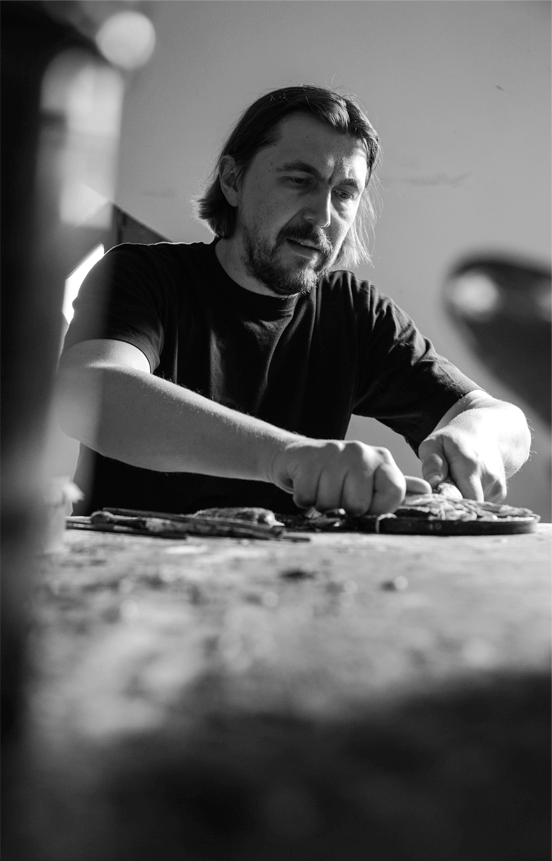
ANTHONY PANZERA: ROBERT HROMEC
Robert Hromec is a rare and unusual talent. He is, all at the same time, an artist, an anthropologist, and an archaeologist. His works function on three different levels, each addressing the tripod of his artistic nature. First there is the artist, the visual level, the level of what you see before you, the work of art on the wall; then there is the contextual, or anthropological level, that which deals with the subliminal and emotional, the historical and mythical level of human kind; and lastly the archaeological level, the level that lies beneath the surface, revealing and exposing the deepest layer in piecemeal form.
I first met Robert at Hunter College in 1997 where he was enrolled in the Master of Fine Arts Program. He had been studying in New York on and off since 1991, first at Pratt Institute, then City College, then finally at Hunter. There he was exposed to a multitude of visual ideas and styles, and was led through a rigorous structure of course work with focus on critical and theoretical thinking. Somehow, in the midst of this program focused on the new, he began to find parallels in the art of the past. In melding them together with the art of the present, he found his own contemporary, meaningful voice.
His is an art which must be experienced, it must be confronted. It cannot exist in a world of words or theories alone. It is only through personal participation with the work that the meaning of all three levels becomes comprehensible. It rushes over the viewer like an emotional waterfall, drawing you into it deeper and deeper.
On the visual level he exposes himself as an artist, a painter’s painter. His use of paint is informed by the finest examples of textured, impasto abstraction expressionist painting, just as his passion for color reminds us of the best combinations of the Impressionist and Post-Impressionist eras. His freedom and courage in combining these elements is controlled by the perfection and nuance of his lines. Together, the entire package makes for a veritable feast for the eyes.
The second level of his work, the anthropological level, reveals to us the stories and subjects of both contemporary and ancient times. We find suggestions of motherhood, love, both fraternal and sexual, and war, combined with references to ancient Greece, Rome and Egypt. We see contemporary bodies, and parts of bodies, heads and feet and hands, and most disturbing, the subliminal thread of conflict between rage and passion present from ancient times to present modern-day man.
Last, but not least, is the vocabulary he uses in which these revelations take place. By a complicated process of painted levels of color, layered and dried, one upon the other, he excavates, in the manner of an archeologist, those abandoned levels from below. With bold, intricate and perfectly drawn lines he scrapes and gouges the surface liberating what is underneath and exposing it to the world above. In so doing, he figuratively gives life and meaning to both: that which was hidden and that which is revealed.
In the end, Robert Hromec is an artist of his time and an artist with a message. His message, while somber, is at the same time beautiful in execution and substance. In associating visions of antiquity with images of contemporary man, he completes a timeless connection to the isolation of man in the 21st century.
Anthony Panzera
New York, 2010
Robert Hromec je vzácny a pozoruhodný talent. Zosobňuje súčasne umelca, antropológa a archeológa. Jeho práce pôsobia v troch rôznych rovinách, ktoré spolu určujú statív jeho umeleckej povahy. Na začiatku je to umelec, vizuálna rovina, tá, ktorú vidíte pred sebou, umelecké dielo na stene. Následne prichádza rovina kontextová alebo antropologická, ktorá pojednáva o tom, čo je podprahové a emocionálne, o historickej a mýtickej hladine ľudstva. A napokon rovina archeologická, tá, ktorá leží pod povrchom, tá, ktorá kúsok po kúsku odhaľuje a obnažuje najhlbšiu vrstvu.
Roberta som prvý krát stretol v roku 1997 na Hunter College ako študenta Master of Fine Arts. S menšími prestávkami študoval v New Yorku od roku 1991, najprv na Pratt Institute, neskôr na City College a napokon na Hunter College. Tam bol vystavený množstvu vizuálnych ideí a štýlov a vedený dôsledne štruktúrovaným štúdiom so zreteľom na kritické a teoretické myslenie. Nejako, uprostred štúdia zameraného na to, čo je nové, začal Robert objavovať paralely s umením dávno minulým. Spojením starého a súčasného si našiel svoje vlastné zmysluplné vyjadrenie.
Jeho umenie musí byť zažité a konfrontované. Nemôže existovať len vo svete slov a teórií. Len osobnou účasťou v prítomnosti diela sa dá pochopiť zmysel všetkých troch rovín. Preženie sa divákom ako emocionálny vodopád, ktorý vás do seba vťahuje hlbšie a hlbšie.
Vo vizuálnej rovine sa odhaľuje ako umelec, maliar maliara. Jeho použitie farieb vychádza z najlepších príkladov štrukturálnej, pastóznej a abstraktnej expresionistickej maľby, práve tak, ako nám jeho vášeň pre farby pripomína tie najlepšie kombinácie impresionistickej a postimpresionistickej éry. Slobodu a odvahu v kombinovaní týchto prvkov kontroluje dokonalosťou a citlivosťou kontúr. Výsledok ako celok vytvára očiam skutočnú hostinu.
Druhá, antropologická úroveň jeho diela nám odhaľuje príbehy a predmety ako súčasných, tak aj starovekých čias. Nachádzame náznaky materstva, lásky bratskej aj sexuálnej, vojny, a to všetko v kombinácii s odkazmi na antický Rím, Grécko a Egypt. Vidíme moderné telá, časti tiel, hlavy, nohy a ruky a veľmi nepokojnú podprahovú hrozbu konfliktu hnevu a vášne prítomnú od antických čias až po súčasný svet moderného človeka.
V neposlednom rade, všetky tieto odhalenia sa nachádzajú práve vo výrazových prostriedkoch, ktoré používa. Komplikovaným procesom nanášania farieb, ich vrstvením, sušením a prekrývaním, rovnako ako archeológ, z hĺbky vykopáva zabudnuté vrstvy. Smelými, spletitými a dokonale prevedenými kontúrami zoškrabuje a zotiera povrch, čím oslobodzuje to, čo je pod ním a odhaľuje to svetu nad ním. Týmto metaforicky dáva život a zmysel obom: tomu, čo bolo ukryté aj tomu, čo je odhalené.